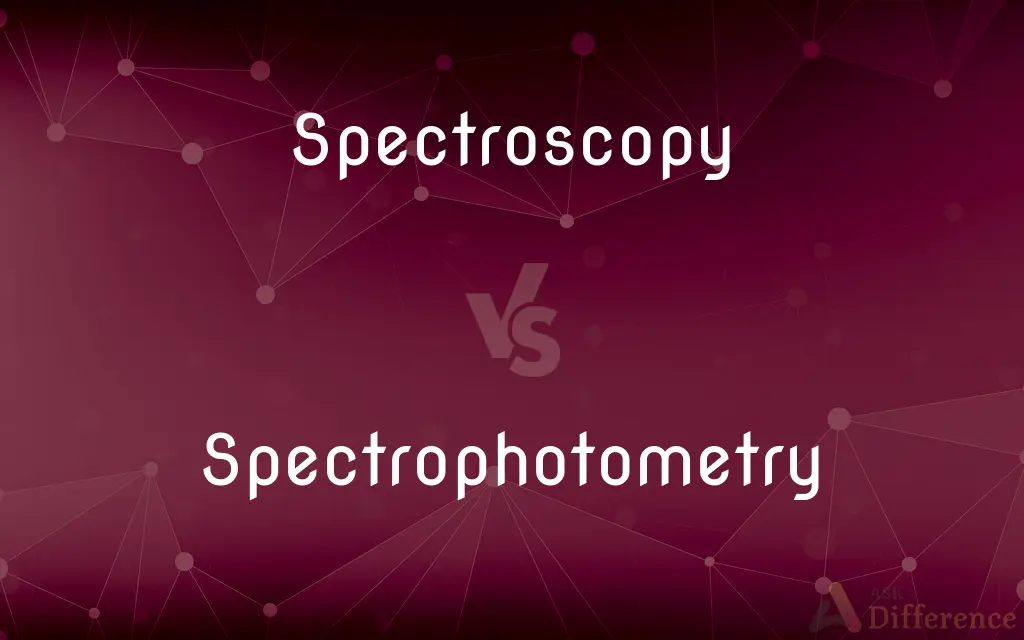Spectroscopy vs. Spectrophotometry — What's the Difference?
Edited by Tayyaba Rehman — By Maham Liaqat — Updated on March 26, 2024
Spectroscopy involves the study of the interaction between matter and electromagnetic radiation, while spectrophotometry measures the intensity of light absorbed by a sample at specific wavelengths.

Difference Between Spectroscopy and Spectrophotometry
Table of Contents
ADVERTISEMENT
Key Differences
Spectroscopy is a broad scientific technique used to analyze the interaction between matter and electromagnetic radiation (light) across the entire electromagnetic spectrum. Spectrophotometry, a subset of spectroscopy, specifically focuses on quantifying how much light is absorbed by a sample at particular wavelengths. This measurement is used to determine the concentration of substances in a sample, making spectrophotometry widely used in biochemical, medical, and chemical research.
Spectroscopy encompasses a variety of methods based on the type of radiation-matter interaction being studied, such as absorption, emission, fluorescence, and scattering. These methods provide qualitative and quantitative information about the sample, including identifying unknown substances and determining molecular structure. Spectrophotometry, on the other hand, specifically deals with the absorption of light and is commonly used in analytical chemistry to quantify molecules in solution by measuring how much light is absorbed at a specific wavelength, related to the molecule's concentration according to Beer-Lambert's law.
While spectroscopy provides a wide range of information about the structural and electronic properties of molecules, spectrophotometry offers a precise quantitative analysis of sample concentration. Spectroscopy can be used to study various states of matter (solid, liquid, gas) and a wide range of materials, whereas spectrophotometry is typically used for analyzing solutions.
Both techniques use instruments that include a light source and a detector, but spectrophotometers specifically measure the intensity of light before and after it passes through a sample to calculate the absorbance. Spectroscopy instruments may also include components like monochromators and diffraction gratings to analyze the light's interaction with the sample in more detail.
The choice between spectroscopy and spectrophotometry depends on the information sought. If the goal is to understand a substance's composition or structure, spectroscopy offers the needed tools. For measuring the concentration of a substance in a sample, spectrophotometry provides the precision and accuracy required.
ADVERTISEMENT
Comparison Chart
Definition
Study of the interaction between matter and electromagnetic radiation.
Measurement of light absorbed by a sample at specific wavelengths.
Purpose
To analyze composition, structure, and properties of matter.
To quantify the concentration of substances in a sample.
Methods
Absorption, emission, fluorescence, scattering, etc.
Absorption of light at specific wavelengths.
Application Fields
Chemistry, physics, astronomy, and more.
Biochemical, medical, chemical research, and more.
Information Obtained
Qualitative and quantitative analysis of matter.
Quantitative analysis of sample concentration.
Typical Use
Identifying substances, studying molecular structure.
Determining the concentration of molecules in solution.
Instrument Components
Light source, detector, possibly monochromators, diffraction gratings.
Light source, detector, cuvettes for holding samples.
Compare with Definitions
Spectroscopy
Provides detailed information on molecular structure and composition.
Nuclear magnetic resonance (NMR) spectroscopy determines molecular structures in chemistry.
Spectrophotometry
Utilizes Beer-Lambert law to relate absorbance to concentration.
Determining the concentration of a colored solution by its absorbance.
Spectroscopy
Can study various states of matter (solid, liquid, gas).
X-ray spectroscopy examines the elemental composition of solids.
Spectrophotometry
Measures the intensity of light absorbed by a sample at specific wavelengths.
UV-visible spectrophotometry quantifies DNA concentration in a solution.
Spectroscopy
Encompasses diverse methods for qualitative and quantitative analysis.
UV-visible spectroscopy measures the absorbance of light by chemical substances.
Spectrophotometry
Essential in analytical chemistry for determining substance concentration.
Colorimetric assays in biochemistry use spectrophotometry.
Spectroscopy
Broad application in identifying and studying substances.
Raman spectroscopy is used for characterizing materials' molecular structure.
Spectrophotometry
Relies on precise instruments for quantitative analysis.
A spectrophotometer calculates the concentration of proteins in a sample.
Spectroscopy
Technique analyzing matter's interaction with electromagnetic radiation.
Infrared spectroscopy identifies functional groups in organic compounds.
Spectrophotometry
Specific for analyzing solutions and their components.
Spectrophotometry is used to measure the levels of pollutants in water.
Spectroscopy
Spectroscopy is the study of the interaction between matter and electromagnetic radiation as a function of the wavelength or frequency of the radiation. In simpler terms, spectroscopy is the precise study of color as generalized from visible light to all bands of the electromagnetic spectrum; indeed, historically, spectroscopy originated as the study of the wavelength dependence of the absorption by gas phase matter of visible light dispersed by a prism.
Spectrophotometry
Spectrophotometry is a branch of electromagnetic spectroscopy concerned with the quantitative measurement of the reflection or transmission properties of a material as a function of wavelength. Spectrophotometry uses photometers, known as spectrophotometers, that can measure the intensity of a light beam at different wavelengths.
Spectroscopy
The study of spectra, especially experimental observation of optical spectra or mass spectra, to determine the properties of their source.
Spectrophotometry
An instrument used to determine the relative intensity of various wavelengths in a spectrum of light.
Spectroscopy
A variety or instance of such study.
Spectrophotometry
The quantitative analysis of electromagnetic spectra by use of a spectrophotometer; especially in order to determine the structure or quantity of a substance
Spectroscopy
(uncountable) The scientific study of spectra.
Spectrophotometry
The art of comparing, photometrically, the brightness of two spectra, wave length by wave length; the use of the spectrophotometer.
Spectroscopy
The use of spectrometers in chemical analysis.
Spectrophotometry
The art or process of measuring the degree of absorption of light at different wavelengths by a chemical substance, by means of a spectrometer or spectrophotometer. It is a technique for chemical analysis.
Spectroscopy
The art and science dealing with the use of a spectroscope, and the production and analysis of spectra; the action of using a spectroscope.
Spectroscopy
The use of spectroscopes to analyze spectra
Common Curiosities
What role does spectrophotometry play in medical research?
It's used to quantify various biomolecules in clinical samples, crucial for diagnosing diseases and monitoring treatments.
What distinguishes spectroscopy from spectrophotometry?
Spectroscopy studies matter's interaction with electromagnetic radiation broadly, while spectrophotometry specifically measures light absorption to quantify substance concentrations.
How does spectroscopy contribute to astronomy?
It helps in identifying the composition and properties of distant stars and galaxies by analyzing the light they emit.
What's the difference in instruments used in spectroscopy and spectrophotometry?
Spectroscopy instruments may include advanced components for detailed analysis, while spectrophotometers focus on measuring light absorbance.
How does the Beer-Lambert law relate to spectrophotometry?
It describes the linear relationship between the absorbance of light by a solution and the concentration of the absorbing species, fundamental to spectrophotometry.
How are the results of spectrophotometry presented?
Results are typically presented as absorbance or transmittance, which can be used to calculate the concentration of the sample.
Is spectrophotometry only used in solution analysis?
Primarily, yes. It's particularly effective for analyzing the concentration of substances in liquid solutions.
Can spectroscopy determine the structure of molecules?
Yes, certain types like NMR and X-ray spectroscopy can provide detailed information on molecular structure.
Why is spectroscopy important in chemical analysis?
It allows scientists to understand the composition, structure, and dynamic processes of chemical substances.
Can spectroscopy identify substances?
Yes, spectroscopy can identify substances by analyzing how they interact with different wavelengths of light.
What advantages does UV-visible spectroscopy offer?
It's versatile for studying a wide range of molecules, especially those with conjugated systems, by analyzing their absorption in the UV-visible range.
Do all spectroscopic methods require a light source?
Yes, all spectroscopic methods involve the interaction of light with matter, though the type of light and method of interaction vary.
Can spectrophotometry measure the purity of a substance?
Yes, by measuring absorbance at specific wavelengths, it can indicate the presence of impurities based on expected absorbance values.
Share Your Discovery

Previous Comparison
Patriarchal vs. Egalitarian
Next Comparison
Unqualified vs. AbsoluteAuthor Spotlight
Written by
Maham LiaqatEdited by
Tayyaba RehmanTayyaba Rehman is a distinguished writer, currently serving as a primary contributor to askdifference.com. As a researcher in semantics and etymology, Tayyaba's passion for the complexity of languages and their distinctions has found a perfect home on the platform. Tayyaba delves into the intricacies of language, distinguishing between commonly confused words and phrases, thereby providing clarity for readers worldwide.















































